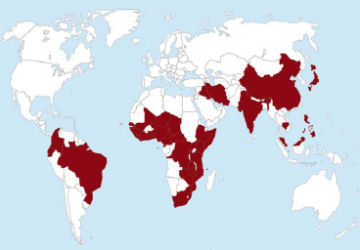Vaccine Harvest: Cholera fighter could be easy to swallow
By genetically modifying rice plants, scientists have created an edible vaccine that triggers an immune reaction capable of neutralizing cholera toxin, tests in mice show. But the researchers stress that the altered rice wouldn’t be sold in stores, grown openly, or be eaten as food. Rather, they envision rice-powder capsules or pills that would deliver the vaccine.

The bacterium Vibrio cholerae spreads through contaminated drinking water. In the body, the microbe attaches to intestinal tissues and releases its toxin, which causes severe diarrhea. The ensuing dehydration can be fatal.
To fashion the new vaccine, immunologist Hiroshi Kiyono of the University of Tokyo and his colleagues engineered rice plants to make grains that contain a harmless fragment of the cholera toxin. Over 12 weeks, mice received six doses of this rice in a powdered, uncooked form mixed with water. Other mice got normal rice powder.
The animals getting the vaccine fended off a subsequent oral dose of full-strength cholera toxin, while mice that had received regular rice powder experienced severe diarrhea, the researchers report in the June 26 Proceedings of the National Academy of Sciences. Further tests showed that the vaccine induced antibody production in cells lining the intestines, the front line of defense in a cholera infection.
Because the new vaccine could be taken orally, health workers wouldn’t need syringes to vaccinate a person, Kiyono says. That would cut costs, avoid accidental needle sticks, and eliminate syringe-disposal problems that accompany current injectable vaccines.
Moreover, the rice containing the vaccine remained unchanged after storage at room temperature for up to 18 months, the researchers report. Tablets or capsules made from such rice would be equally stable, Kiyono predicts. In developing countries, keeping vaccine vials in cold storage is expensive and unreliable because of frequent power outages.
The experimental vaccine has other features that make it appealing, says microbiologist Andrew Camilli of the Howard Hughes Medical Institute and Tufts University School of Medicine in Boston. Tests by Kiyono’s group show that the toxin fragment resists degradation by harsh stomach acids. And a slightly altered form of this vaccine might prevent diarrhea caused by Escherichia coli because that microbe’s toxin is similar to cholera’s, Camilli says.
However, he notes that the Japanese researchers tested the new vaccine by exposing mice to cholera toxin but not to live V. cholerae, which would have more closely replicated actual infection.
Microbiologist James B. Kaper of the University of Maryland in Baltimore says that the composition of the vaccine might limit its potency. “This vaccine would give antitoxin immunity [which] could help contribute to protection by combination vaccines,” he says. “But there’s no evidence in humans that antitoxin immunity alone would protect” against cholera infection.
Another oral cholera vaccine being tested in people uses killed bacterial cells to engender immunity (SN: 12/4/04, p. 366). That vaccine has shown mixed results in tests in South America, Mozambique, and Vietnam.
Kiyono acknowledges that the genetically modified rice would need to be grown in conditions that keep it separate from normal crops.







